#Vera x vox
Text

Hey fellas, when you’re choking out a lady (consensually) when is it appropriate to tell her you might’ve fallen in love with her?
Asking for a friend…
#hazbin hotel vox#vox#vox x reader#vera x vox#hazbin hotel#hazbin art#hazbin hotel oc#hazbin hotel x reader
509 notes
·
View notes
Text


"So.. Is he watching?"
"He most certainly is."

Valentino had gotten his hands on another couple of Velvette's models again, and since it was the evening of her fashion show and the debut of her new line "Under Satin", she got Vera and Lila to model it for her. Mainly as revenge for Vox not keeping his Boy Toy in check. But the girls were happy to help and make the Flat-Faced Prince sweat a little more...



I finally coloured it, @timeslugarts ! <3
Lineart here.
youtube
#hazbin hotel#hazbin hotel vox#hazbin hotel valentino#hazbin hotel velvette#hazbin hotel vees#vox x vera#vera x vox#vox x oc#vox x reader#vox x lila sinclair#vox x lila#timeslugarts#my art 🎨#Youtube#gonna be honest#i dont even know how i managed to do this
88 notes
·
View notes
Text
Was scrolling through the radioapple tag until i found @missfortunegirl ‘s ship kid designs so i drew them
+ bonus lulu land sophia





#radioapple#stolitz#staticmoth#lucifer x alastor#stolas x blitz#vox x valentino#someone get vera new parents stat
11 notes
·
View notes
Text
They are silly your honor
I Drew the cuties @timeslugarts I'm not best at drawing vox but I tried! Worth it for Vera

12 notes
·
View notes
Text



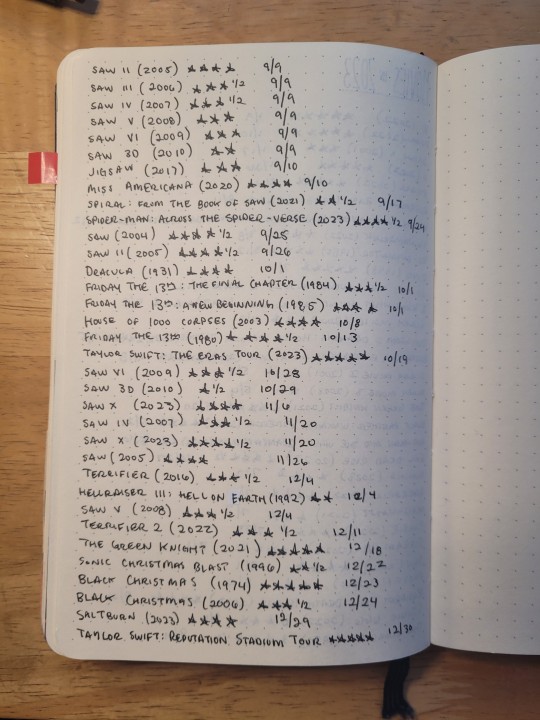
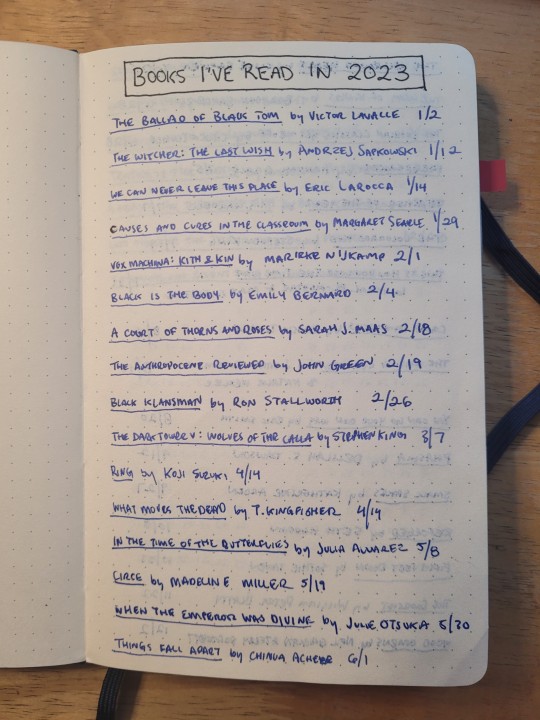
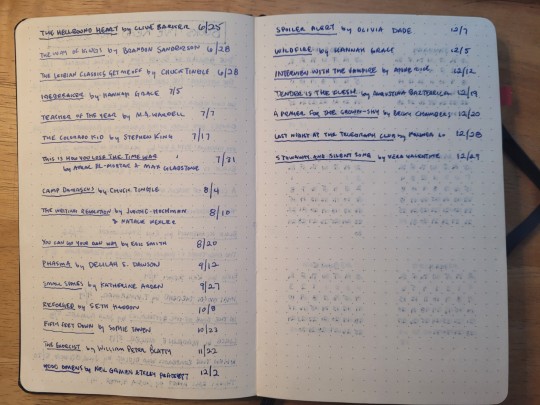
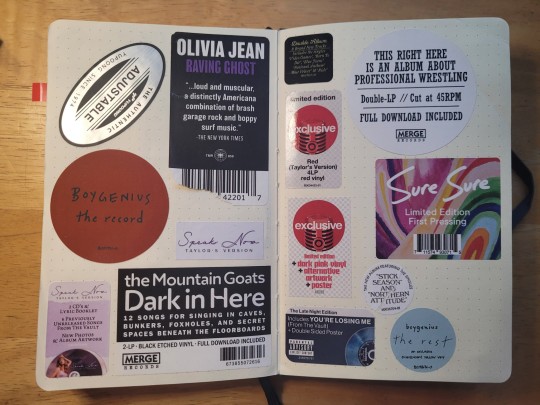

2023 Bullet Journal Cover & Lists
- movies
- books
- physical music stickers
(typed list below cut)
Movies
X (2022) ★★★★★ 1/9
Pearl (2022) ★★★★★ 1/10
Jason X (2001) ★★★ 1/17
X (2022) ★★★★★ 1/26
Pearl (2022) ★★★★★ 2/11
Rosemary's Baby (1968) ★★★★★ 2/11
Harley Quinn: A Very Problematic Valentine's Day Special (2023) ★★★★★ 2/12
Skinamarink (2022) ★★★★ 3/8
Re-Animator (1985) ★★★★ 3/12
Ring (1998) ★★★★★ 3/12
Ju-On: The Grudge (2002) ★★★★ 3/12
I Know What You Did Last Summer (1997) ★★★★ 4/2
Scary Movie (2000) ★★★ 4/3
Dungeons & Dragons: Honor Among Thieves (2023) ★★★★★ 4/5
Everything Everywhere All at Once (2022) ★★★★★ 4/18
Scary Movie 2 (2001) ★★★ 5/3
Scary Movie 3 (2003) ★★ 5/4
The Green Knight (2021) ★★★★★ 5/20
Black Panther: Wakanda Forever (2022) ★★★★ 5/21
Ant-Man and the Wasp: Quantumania (2023) ★★ 6/6
Evil Dead Rise (2023) ★★★★1/2 6/27
Nimona (2023) ★★★★ 7/2
Barbarian (2022) ★★★★ 7/6
Malignant (2021) ★★★★ 7/7
Barbie (2023) ★★★★★ 7/23
Scream VI (2023) ★★★1/2 8/1
Saw (2004) ★★★★ 8/1
Frozen (2010) ★★ 8/2
Resident Evil: Death Island (2023) ★★★★ 8/21
Studio 666 (2022) ★★★★ 9/4
The Exorcist (1973) ★★★★1/2 9/4
Saw II (2005) ★★★★ 9/9
Saw III (2006) ★★★1/2 9/9
Saw IV (2007) ★★★1/2 9/9
Saw V (2008) ★★★ 9/9
Saw VI (2009) ★★★ 9/9
Saw 3D (2010) ★★ 9/9
Jigsaw (2017) ★★★ 9/10
Miss Americana (2020) ★★★★ 9/10
Spiral: From the Book of Saw (2021) ★★1/2 9/17
Spider-Man: Across the Spider-Verse (2023) ★★★★1/2 9/24
Saw (2004) ★★★★1/2 9/25
Saw II (2005) ★★★★1/2 9/26
Dracula (1931) ★★★★ 10/1
Friday the 13th: The Final Chapter (1984) ★★★1/2 10/1
Friday the 13th: A New Beginning (1985) ★★★★ 10/1\
House of 1000 Corpses (2003) ★★★★ 10/8
Friday the 13th (1980) ★★★★1/2 10/13
Taylor Swift: The Eras Tour (2023) ★★★★★ 10/19
Saw VI (2009) ★★★1/2 10/28
Saw 3D (2010) ★1/2 10/29
Saw X (2023) ★★★★1/2 11/6
Saw IV (2007) ★★★1/2 11/20
Saw X (2023) ★★★★1/2 11/20
Terrifier (2016) ★★★1/2 12/4
Hellraiser III: Hell on Earth (1992) ★★ 12/4
Saw V (2008) ★★★1/2 12/4
Terrifier 2 (2022) ★★★1/2 12/11
The Green Knight (2021) ★★★★★ 12/18
Sonic Christmas Blast(1996) ★★1/2 12/22
Black Christmas (1974) ★★★★★ 12/23
Black Christmas (2006) ★★★1/2 12/24
Saltburn (2023) ★★★★ 12/29
Taylor Swift: Reputation Stadium Tour (2018) ★★★★★ 12/30
Books
The Ballad of Black Tom by Victor Lavalle 1/2
The Witcher: The Last Wish by Andrzej Sakowski 1/12
We Can Never Leave This Place by Eric Larocca 1/14
Causes and Cures in the Classroom by Margaret Searle 1/29
Vox Machina: Kith & Kin by Marieke Nijkamp 2/1
Black is the Body by Emily Bernard 2/4
A Court of Thorns and Roses by Sarah J. Maas 2/18
The Anthropocene Reviewed by John Green 2/19
Black Klansman by Ron Stallworth 2/26
The Dark Tower V: Wolves of the Calla by Stephen King 3/7
Ring by Koji Suzuki 4/14
What Moves the Dead by T. Kingfisher 4/14
In the Time of the Butterflies by Julia Alvarez 5/8
Circe by Madeline Miller 5/19
When the Emperor Was Divine by Julie Otsuka 5/30
Things Fall Apart by Chinua Achebe 6/1
The Hellbound Heart by Clive Barker 6/25
The Way of Kings by Brandon Sanderson 6/28
The Lesbian Classics Get Me Off by Chuck Tingle 6/28
Icebreaker by Hannah Grace 7/5
Teacher of the Yearby M.A. Wardell 7/7
The Colorado Kid by Stephen King 7/17
This is How You Lose the Time War by Amal El-Mohtar & Max Gladstone 7/31
Camp Damascus by Chuck Tingle 8/4
The Writing Revolution by Judith C. Hochman & Natalie Wexler 8/10
You Can Go Your Own Way by Eric Smith 8/20
Phasma by Delilah S. Dawson 9/12
Small Spaces by Katherine Arden 9/27
Reforged by Seth Haddon 10/8
Fifty Feet Down by Sophie Tanen 10/23
The Exorcist by William Peter Blatty 11/22
Good Omens by Neil Gaiman & Terry Pratchett 12/2
Spoiler Alert by Olivia Dade 12/7
Wildfire by Hannah Grace 12/5
Interview With the Vampire by Anne Rice 12/12
Tender is the Flesh by Augustina Bazterrica 12/19
A Prayer for the Crown-Shy by Becky Chambers 12/20
Last Night at the Telegraph Club by Malinda Lo 12/28
Stowaway and Silent Song by Vera Valentine 12/29
Physical Music Media:
(this isn't all of the records/CDs I've gotten or listened to this year, but I figured I'd decipher the stickers I put in the book; these are all of the promo stickers on the outside of the plastic wrapping on the releases)
Beat the Champ - the Mountain Goats
Paradise - Lana del Ray
Red (Taylor's Version) - Taylor Swift
What's it Like? - Sure Sure
Did You Know There's A Tunnel Under Ocean Boulevard? - Lana del Ray
Stick Season - Noah Kahan
The Rest - boygenius
Midnights (Late Night Edition) - Taylor Swift
Raving Ghost - Olivia Jean
The Record - boygenius
Speak Now (Taylor's Version) - Taylor Swift
Dark in Here - the Mountain Goats
Bangerz (10th Anniversary Edition) - Miley Cyrus
God Games - the Kills
1989 (Taylor's Version) - Taylor Swift
#mine#studyblr#notes#aesthetic#bujo#bullet journal#bujolife#bujo aesthetic#bujoinspo#bujoblr#bujo list#2023 reap#booklr#books#film
34 notes
·
View notes
Text
Introducing Snack Stories
Character facts, dialogue, and songs I compare to them bellow!!
Okay fine I have writer’s block if it isn’t obvious, and I’m also overwhelmed currently with school and my family brought home a dog and NOW A KITTEN TOO LIKE GUYS ITA A ZOO IN HERE
So until inspiration on where to go with chapter two strikes, I’ve been randomly thinking up little things for the AU like OCs and small moments between characters that I think are cute. So I’ll now be providing small little moments between chapters that aren’t very important to the story but like just giving little bite sized story.
Like I want to do some of Violet and Alastor as kids interacting, or of Alastor teaching Annie how to dance to his favorite music. Maybe even Vox hating Alastor but being unable to hate Annie despite how similar she looks, because she acts just like Violet and it’s his niece at the end of the day, even if it’s also Alastor’s brat.
Idk between the stress and not knowing where to go with chapter two, this seems more manageable for now 💜
DW I’ll break y’all’s hearts with the actual story eventually
I love Alastor sm it’s a problem so obviously i need to traumatize him and drag yall along for the ride!!
Okay a few thing to make it up to yall!!
Music that I relate to these characters (should I just link the playlist I have? If so what platform works for yall?)
Violet being delulu and in love with Alastor and not seeing he’s dangerous and not a very good person (same girl same)
Violet x Alastor about each other bc he can be sweet just only with his people
Alastor about Violet
Rosie and Wisteria (they have their own post too)
How my human Husk and Angel feel about one another
A bit about Violet:
Honestly she can be so sweet a lot of the time, and she truly thinks the best of everyone.
So it’s even more shocking when she loses her shit if Annie, Alastor, or even Vox when he was small get hurt.
Seriously do not hurt her family you will not like the outcome.
Alastor is very proud the first time he sees her out for blood, which was after he got picked on for being mixed race.
She straight up tried to fight a boy twice her size for Al and she won.
“Violet!! Are you okay?! You didn’t have to do that…” He looked concerned seeing her bloody lip and a couple bruises on her. He didn’t expect his petite friend to chase his bully across campus like that…
“Yeah? I’m fine Al! I ain’t that banged up. That son of a biscuit is far worse off rest assured! Heh… anyway I’m probably going to be suspended so try to hold out for a few days huh?” Violet smiles like this was completely normal and it wasn’t at all surprising she beat the shit out of an upperclassmen…
On one occasion as adults she had seen a grown man trying to coax Annie into following him while they were at a park. She politely asked him to leave her daughter be, but after the man continued being creepy she punched him in the face before picking Annie up and going to find Alastor so they could leave
Said man later went missing but Alastor swears it’s a coincidence (The blood on his dress shirt said otherwise)
Violet doesn’t know about Alastor’s hobby at first, but finds out about ten years into their marriage
After learning he only kills dangerous people who harm others, she’s fine with it, but he can’t kill Vox
“You cannot kill my little brother!!” She argued to him
“He fits my rules!”
“HES MY BROTHER”
“You and your emotional connections!”
“You’re one to talk! Remember when Annie spilt her juice on that damned Radio?! You mourned it like a person!”
“That Radio was my baby, Violet!”
“ANNIE IS YOUR LITERAL BABY”
Other than that it’s fine
#alastor#hazbin hotel oc#dad alastor#hazbin alastor#hazbin hotel#hazbin hotel alastor#hazbin hotel fankid#human alastor#alastor the radio demon#hazbin hotel fanfiction#hazbin rosie#hazbin hotel husk#rosie hazbin hotel#hazbin hotel rosie#hazbin vox#alastor fanfiction#alastor and rosie#platonic radiorose#queerplatonic radiorose#radiorose#papa alastor#father alastor#human vox#human!alastor#hazbin human au#hazbin hotel vox#huskerdust#hazbin husk#huskdust#angel dust x husk
7 notes
·
View notes
Text
Hazbin Hotel Master List
Vox x Reader
Angin
Vera(oc) is just looking for a little fun. Though she may end up with more than she bargains.
(Vera is not my OC and this is not canon to timeslugarts storyline. Just a bit fun)
0 notes
Text
VIRGINIA MAESTRO..cosas q recordar o destacar de ese viaje con motivo del FESTIVAL DREAM_BEACH de VILLA_RICOS cn acampada en Playa de PALOMARES anexa a la playa nudista de VERA [=CIERTO o VERDADERO] q empezo yendo a AL_MERIA y acabo en AL_I_CANTE [en cuyo puerto tenían atracado una Replica del buque SANTISIMA TRINIDAD o buque INSIGNIA de la Batalla de TRAFALGAR q los INGLESES intentaron remolcar a GIBRALTAR pero se hundio]
1_ Estatua de JOHN LENNON en AL_MERIA xq ahí rodó COMO GANE LA GUERRA y compuso STRAWBERRY FIELDS
2_Anuncio en AL_MERIA del concierto SINFONICO de tu Paisano RAPHAEL para el q compusiste EN PIE del cd INFINITOS BAILES del q hizo la gira LOCO POR CANTAR..así como cartel de revista ESQUIRE con APOCALIPSIS VIGGO MORTENSEN en una peluqueria
3 hotel REINA de VERA en el q estuve en agosto 2021
4 DJ "D&C" [Dios y Cristo] en la acampada de PALOMARES con camiseta del 23 JORDAN y al q luego me encontré en la playa de VERA con su novia q nos hizo la foto.
5 mi tienda de campaña q pude montarla solo en el parque JUANCARLOS I cuando ENSAYE..pero q en PALOMARES me tuvo q ayudar una CHICA y en la cual me bebi un botella de Vodka_matarratas VOX=partido politico para borrachos o ciegos de patriotismo.
6 viendo cerrar de 7 AM a 9 AM el Festival a mil_millonario Armin Van Buuren al q vi en la Nochevieja de 2010 en MELBOURNE cobrar 100 Dólares australianos [bebida aparte]..a más de 50.000 jóvenes en el ESTADIO CONVERTIBLE "MARVEL"
7 tarjeta de la PENSION LA PURISIMA de CARTAGENA a donde fui directamente desde el FESTIVAL en un Autobús con una RESACA ENORME y ABANDONANDO LA TIENDA [me costó 30 € en el CARREFOUR=ENCRUCIJADA] y en cuyo CORTE INGLES me fotografie en EL ESPACIO DE MUSICA con el LP THE WALL de PINK FLOYD [entre LP ANIMALS y LP THE FINAL CUT]
8 haciendo la V entre la UNION [donde me fotografie a LA VUELTA desde el tren ligero o donde nacio tu padre]..y LA ESPERANZA del cartel de paradas de la LINEA entre CARTAGENA Y LOS NIETOS
9 Pintada de CRISTO Y/O CRISTA xq la A esta en un Circulo así como otra de malogrado NINO BRAVO en la playa PARAISO
10 tarjeta de mi estancia en Hotel de los DEL_FIN_ES del MAR DE MENOR cuando murió el MANZANA o padre de MICHEL GONZALEZ [q Marco 3 goles a korea en ITALIA'90 gritando ME LO MEREZCO mientras yo veía mi 1er concierto ese 17_6_90 gira URBAN JUNGLE de los ROLLING STONES con GUN de TELONEROS a cuyo escenario el 26_5_92 en sala UNIVERSAL SUR en LEGANES me subí cuando su bajo DANTE GIZZI cerro el concierto cantando SMELL LIKE TEEN SPIRIT del cd NEVERMIND de nIrVANa y siendo retransmitido su siguiente concierto en la EXPOSICION UNIVERSAL DE SEVILLA'92 x Canal +]..el cual luego casaría a su hijo en EL MAR MENOR
11 anuncio del concierto de LOQUILLO en el MAR MENOR que fue antes de mi llegada






























0 notes
Audio
X Ray Pop - Xmas Pop: French Pop Synth Noise Songs 1985-1999
How can I resist a subtitle like that?
Finders Keepers sister label Cache Cache and X-Ray Pop’s Doc Pilot inaugurate an ongoing collaboration to plunder the hidden depths of one of the most original and productive independent groups of the French DIY domestic synth pop/pocket punk funk/homemade tape scene with this cut AND paste Christmas cartridge of well loved and unknown festive interference spanning the first 20 years of the groups self-propelled anti-career. With a consistent omnipresence on European tape co-ops through the 80s and early 90s this troupe of battery operated cabaret cosmonauts combine duel French femme vox with alternating dreamy metronomic private pop or erratic pulsating cosmic rock via their Casio-to-cassette production line. A standout track on the lauded rare alternative funk compilation and sited as a closely guarded influence for the well informed X-Ray Pop are a group who are easy to scratch the surface but almost impossible to get the bottom of, with a warren of unexplored passages they truly are a band with musical gift that keeps on giving!
Precariously bridging gaps between Fontaine, Robeiro, Sunforest, Cluster, ESG, Williams and Currie, The Plastics, Weekend, Stereolab and faithful generations of adventurous continental Walkmans, this group sends a 9v current from Elli and Jacno to Elly and Rikkert and, if at all possible, provides pop punks equivalent of Vera Chytilova’s Daisies, maybe… Joyeux Noël!
#X Ray Pop#Xmas Pop#christmas music#france#finders keepers#cacne cacne#doc pilot#1980s#1990s#electronic#synthpunk#postpunk#female vocal
7 notes
·
View notes
Link
Nonantola, al Vox arriva Anastasio, il vincitore di X-Factor "La fine del mondo tour 2019" approda sul palco con il trionfatore del talent 31 Marzo 2019 NONANTOLA. “La fine del mondo tour 2019” di Anastasio il 12 aprile fa tappa al Vox Club di Nonantola. Una vera e propria febbre per la prima to... https://ift.tt/2YJaJSS
0 notes
Text

Ohmigod this image is killing me.
Look at those HEELS!
And the scars????
Most importantly, I FINALLY know what's under his ridiculous outfit hurray 🎉
604 notes
·
View notes
Text



Valentino had gotten his hands on another couple of Velvette's models again, and since it was the evening of her fashion show and the debut of her new line "Under Satin", she got Vera and Lila to model it for her. Mainly as revenge for Vox not keeping his Boy Toy in check. But the girls were happy to help and make the Flat-Faced Prince sweat a little more...

Coloured drawing here.

youtube
I'm too nervous and sleep-deprived to colour this rn. (My boyfriend is coming over to my country to visit me today, aaa-) But! I just wanted to say thank you for your lovely Vera/Lila drawing, @timeslugarts. Also, hmm, I wonder what Vox's reaction whilst in the audience would be... 😈
#hazbin hotel#hazbin hotel vox#my hazbin hotel oc#vox x oc#hazbin hotel original character#vox x vera#vera#vox x lila sinclair#lila sinclair#Lila and Vera#my art 🎨#feel better soon#Youtube#vox x lila
20 notes
·
View notes
Link
“Get that thing off your skull.”
That’s something my mom says just about every time she sees me with a cellphone pressed against my ear. She also worries about cellphones in pockets, telling my brothers that they’re “frying their testicles” with their devices.
My mother is voicing something many cellphone users, or parents of cellphone users, intuitively feel: that these devices are somehow making us sick.
Though I have never been particularly concerned about cellphone radiation and cancer, my phone makes me uneasy. It commands too much of my attention. It sucks up too much of my time. And it feels unwise to have its heat so close to my brain.
But as anyone who’s had suspicions can tell you, it isn’t easy to find clear answers. Over the years, reports on the science of cellphone radiation and health haven’t been very satisfying, especially on cancer — the ultimate cellphone health concern.
Single studies have alternately suggested cellphones are driving up cancer rates and that they pose no health threat at all. In 2011, the World Health Organization (WHO) declared that the devices are a “Class 2B carcinogen,” meaning they possibly can cause cancer in humans — but that’s also a distinction they share with pickles, aloe vera, and being a carpenter.
A much-anticipated series of studies, released in draft in February 2018 by the National Toxicology Program of the National Institutes of Health (NIH), went to great lengths to study the effects of cellphone radiation in rats and mice. The researchers had an equally difficult time forming conclusions. (More on that below.)
A fringe group of science deniers occasionally captures attention for voicing concerns about cellphones and other types of non-ionizing radio-frequency radiation exposure, such as the energy emitted from wifi routers in schools. They’re routinely debunked, and the debunkers rightly note that cellphones are also just one of many radiation sources we all live with. (Even the Earth itself, the air we breathe, and the sun and stars in our galaxy constantly give off radiation.) Adding to the confusion: Wireless companies have reportedly attempted to shape cellphone research and discredited researchers whose findings are inconvenient.
Yet as cellphones have become more and more ubiquitous in the US over the past decade and a half, brain tumor rates — both cancerous and benign — have not been going up.
But there is also some ambiguity about cellphone radiation’s health effects. As Dr. John Bucher, a senior scientist at the National Institute of Environmental Health Sciences and a co-author of the NIH studies, told me, “[Our results] go against the notion that non-ionizing radiation is completely harmless.” In other words, he’s found that the type of radiation cellphones give off could cause biological changes, like promoting tumors, at least in animals.
As I started poking around on cellphone radiation, many researchers expressed the same concern: We can’t fully understand its potential impact on human health because the way we live with these radiation-emitting devices keeps changing.
Our cellphone dependency now starts in childhood, and “nobody has looked at this issue in kids, where their brains and skulls are developing,” said Otis Brawley, the chief medical and scientific officer for the American Cancer Society, though studies are underway.
Welcome to Show Me the Evidence, where we go beyond the frenzy of daily headlines to take a deeper look at the state of science around the most pressing health questions of the day.
We’re also exposed to radio-frequency radiation from the networks that connect our phones. And while the coming rollout of 5G, or fifth-generation, wireless networks is expected to transmit data faster than ever, it will also increase the number of antennas sending signals to mobile devices, and potentially our exposure to radiation, with unclear health effects. (That’s why 180 scientists from around the world signed a petition in September 2017 asking for a moratorium on the rollout of 5G networks in the European Union until the health effects of the networks are better understood.)
With the help of clinical epidemiologist Dylan Collins, I scoured the best available medical studies on cellphone radiation and head and neck cancers or benign tumors, as part of Vox’s Show Me the Evidence series.
As Jonathan Samet — the dean of the Colorado School of Public Health, who advised the World Health Organization on cellphone radiation and cancer — told me, you can argue anything based on the science we currently have “because there’s not enough evidence to start with.” Actually, there’s not enough high-quality evidence. Before we get into why, and what we know, we need a quick primer on cellphone radiation.
The reason we’re talking about cellphones and cancer — why there’s a concern here — is because they emit radiation, the invisible waves of electric and magnetic energy, of varying power, organized on the electromagnetic spectrum. You can see in the graphic below that less powerful (or lower-frequency) types of radiation are on the left, moving to the more powerful (or higher-frequency) types of radiation on the right.
Javier Zarracina/Vox
You’ll notice radiation is split into two categories here: ionizing and non-ionizing. The waves emitted from radios, cellphones and cellphone towers, Wi-Fi routers, and microwaves are referred to as “radio-frequency” radiation. That’s a type of “non-ionizing” radiation, since it doesn’t carry enough energy to “ionize” — or strip electrons from atoms and molecules. (Other sources of non-ionizing radiation, as you can see in our chart, include visible and infrared light.)
When it comes to ionizing radiation — which we’re exposed to in X-rays, in CT scans, and during air travel — we know it’s powerful enough to damage the DNA, and that repeated DNA damage over time can cause cancer. That’s why, for example, you’re not supposed to get too many X-rays in your lifetime. (In case you were wondering, there’s no precise number on how many X-rays are too many — but the Food and Drug Administration suggests keeping track and avoiding any that seem unnecessary.)
Again, non-ionizing radiation — the radiation from cellphones — doesn’t have enough energy to break our DNA, and therefore, we have traditionally thought, it couldn’t cause cancer. But there is some question about whether it’s as harmless as was once believed, or whether there might be another mechanism at play, other than direct DNA damage, that could lead to cancer or other biological problems.
“These electromagnetic waves may cause effects on cellular functions but not damage the cells per se,” University of Utah radiation expert Om Gandhi told Vox. And the closer you are to any source of radiation exposure, and the longer you’re exposed, the more radiation absorbs into your body, and the higher the risk of a health effect.
That brings us back to the main question here: Do cellphones cause tumors? We chose to focus this story on cancer risk, since it seems like the most common health concern people have about cellphones. But before we get to the answers, we need to take another (brief) detour to explain how this science has been done with human subjects. To do that, we need to zoom in on a nerdy subject: research methods.
Javier Zarracina/Vox
In many areas of health research, the randomized controlled trial is considered the gold standard of evidence. Researchers take test subjects and randomly assign them to one of two groups. One group gets a treatment; the other gets a placebo.
The idea is that because people were randomly assigned, the only real difference between the groups (on average) is the treatment. So if there’s a difference in outcomes, it’s fair to say that the treatment was probably the cause.
That’s why randomized controlled trials (RTCs) often yield fairly clear answers about the effectiveness of treatments compared to other study designs. (Fun fact: Scottish doctor James Lind, a clinical trial pioneer, figured out that citrus fruits seemed to have an effect on scurvy using one of the earliest RCTs.) RCTs can also be used to study whether something, like cellphone radiation, can cause disease.
Unfortunately, however, we’ll probably never have an RCT on cellphones and cancer in humans. It’d be too difficult and too expensive to randomly assign particular levels of cellphone use to thousands of people and have them stick with those plans for enough time (we’re talking at least five years) to figure out whether certain types of phones or phone use patterns cause cancer to develop. That’s not to mention the fact it’d be nearly impossible to find a group of people willing to not use cellphones and then make sure they actually stick to their promise.
But without RCTs, we can’t establish that cellphones cause cancer or prove that they don’t.
Instead, we have to rely on “observational” data, tracking people’s real-world cellphone use and their disease incidence. Studies using observational data tend to be weaker, messier, and less clear-cut than experimental studies like RCTs. They can only tell us about associations between phenomena, not whether one thing caused another to happen. So that opens up a lot of the ambiguity we’re going to delve into next.
One final wrench in cellphone studies: Some, but not all, have been funded by the cellphone industry, clouding their trustworthiness. You can read more about that in this investigation by the Nation, which has its merits but also strongly implies a causal link between cellphones and cancer based on cherry-picked studies.
When we analyzed the sources of funding behind the 49 cellphone and human health studies — on PubMed, the Cochrane Library, EMF Portal, and SaferEMR — published in the past 10 years, we saw no apparent link between the source of funding and the direction of the conclusions.
In fact, we found the best human studies that aren’t industry-funded on cellphones and cancer all seem to point in the same direction: Using these devices is not associated with an increased risk of brain tumors in humans — though there are many open questions about their health effects. Here’s why.
Javier Zarracina/Vox
To cut through some of the messiness in the data, we took a systematic approach to wading through the evidence. We focused on cancers, as well as benign tumors, of the head and neck, since that’s the body area thought to get the most exposure to radio-frequency radiation during cellphone use.
The three most common brain tumor types — and the ones most cellphone and human health studies focused on — are gliomas (malignant tumors of the brain and spinal cord), meningiomas (mostly noncancerous tumors of the membranes surrounding the brain and spinal cord, though a small percentage are cancerous), and acoustic neuromas (noncancerous tumors on the main nerve that leads from the inner ear to the brain). Note that of these, gliomas are the main concern — they generally have more severe outcomes than meningiomas and acoustic neuromas.
We started with systematic reviews: syntheses of the research evidence that bring together a bunch of studies to come to more fully supported conclusions. (For more on our search strategy, scroll to the end to read our methods section.)
We found 12 systematic reviews on cellphone radiation and head and neck tumors. To determine the quality of each, we used a tool to evaluate systematic reviews called AMSTAR. Eight of the 12 reviews were of “critically low” quality, according to AMSTAR’s criteria, meaning they shouldn’t be relied on to provide an accurate summary of the research.
(Some common flaws in these studies: The summaries of the evidence weren’t comprehensive, the researchers often didn’t look at the quality of the studies they found, and they failed to do other simple things that would limit bias from creeping in. They also relied on case-control studies, a poor method to determine causality — more on that soon.) So we didn’t include these eight reviews in our analysis.
The remaining four did a little better according to AMSTAR — but only ranked “low” or “moderate” quality. They still relied mainly on case-control studies — a very weak type of observational study design when it comes to proving causality.
In case-control studies, researchers start with an endpoint (in this case, people who already have head and neck cancer and people who don’t) and work backward to see what may have contributed to that health outcome (in this case, figuring out how people’s cellphone use patterns may have differed).
For each person with a disease (a case), they find a match (a control) — or someone who doesn’t have the disease. They then look back in time and try to determine if there are any patterns of exposure in those with the disease that aren’t present in those without the disease.
This method is prone to bias. When we look back in time, it’s more difficult to get an objective measure of what happened. For example, when it comes to cellphone use, researchers have to ask people to think back 10, 15, or 20 years and estimate how much they used their mobile devices, or use cellphone records as a proxy.
Additionally, the way researchers match cases to controls tends to be subjective. They try to match based on things we know might affect the outcome, such as socioeconomic status, gender, and age — but it’s impossible to match for everything.
Altogether, the four reviews had somewhat mixed results — which isn’t that surprising since they were not conducted to the best possible standards. Here’s a quick rundown of their findings:
This 2017 review, published in Neurological Sciences, looked at case-control studies on cellphone use, focusing on glioma, meningioma, and acoustic neuromas. This review was interesting because the researchers divided the studies by quality, and higher-quality studies — which tended to be funded by the government and not the cellphone industry — showed a trend toward an increased risk of brain tumors, while lower-quality studies did not. Overall, though, their meta-analysis found an increased risk of brain cancers (mostly gliomas) among people who were using cellphones for 10 or more years, and no increase in the risk of acoustic neuroma.
This 2017 systematic review and meta-analysis, published in PLOS One, looked at mobile phone use in case-control studies and the risk of glioma. “Our results suggest that long-term mobile phone use may be associated with an increased risk of glioma,” they wrote. The researchers found an association between mobile phone use and low-grade glioma in the people who used cellphones regularly or for 10 years or more. “However, current evidence is of poor quality and limited quantity,” they added, and called for prospective studies to confirm the results.
This 2012 systematic review, from Bioelectromagnetics, found no increased risk of glioma, meningioma, or acoustic neuroma at any level of cellphone use.
This 2009 meta-analysis, published in the Journal of Clinical Oncology, looked at 23 case-control studies of the risk of both malignant and benign tumors from mobile phone use. When the authors included all 23, they found no increased risk of tumors. When they crunched certain subsets of the data — like looking only at studies that were blinded, or people who used cellphones for 10 or more years — they did find increases in tumor risks. Confusingly, when they divided up the analysis by tumor type, they found no increase in risk for glioma and acoustic neuroma, and a decrease in risk of meningioma.
Overall, the reviews of case-control studies seem to suggest there is perhaps no risk of cancer with cellphone use — unless you look at some subgroups (like people in blinded studies or people with long-term exposures). But these reviews are based on case-control studies — which are like the National Enquirer of the science world: cheap and often misleading.
So let’s take a look at a stronger type of study design: the cohort study. Unlike case-control studies, cohort studies follow people with a known exposure (e.g., cellphones) through time, waiting to see if, when, and how many people develop a disease (such as cancer).
This means they’re not left searching for artificial controls to match their cases. And since researchers have data that follows people through time, and can sometimes check in on how they’re using their cellphones in real time, they don’t have to rely on people’s memories of the past.
In our search of the literature, we found five recent cohort studies. They looked at populations of 60,000 to 23 million people, examining different levels of cellphone use and whether users went on to develop head and neck cancers or benign tumors like acoustic neuromas:
This 2009 study, funded by the Danish Strategic Research Council and published in the Journal of the National Cancer Institute, tracked nearly 60,000 people across Scandinavia between 1974 and 2003 to look at changes in glioma and meningioma rates.
This 2011 study, also funded by the Danish Strategic Research Council and published in the American Journal of Epidemiology, tracked nearly 3 million people who had used cellphones for more than 11 years.
Taiwanese people were early adopters of cellphones and among the heaviest users in the world. So the National Science Council in Taiwan decided to look at a cohort of 23 million cellphone users over 10 years to see if there was any increase in brain tumors. They published their findings in the European Journal of Cancer Prevention in 2013.
In the UK, Cancer Research UK funded a study, published in the International Journal of Epidemiology in 2013, that allowed researchers to track nearly 800,000 women for seven years to see whether their use of cellphones correlated with an increased risk of head and neck cancers.
In Japan, the government’s Ministry of Internal Affairs and Communications tracked cellphone users from 1993 to 2010 for a 2016 Bioelectromagnetics study.
None of them were funded by the cellphone industry, which suggests they’re less likely to be biased and that we can be more confident in their results. Not surprisingly, their conclusions looked different from what the reviews of lower-quality research uncovered, though not in the direction you might expect.
What did they find? No increased risk in glioma or meningioma tumors, while one (the British study) found a small increased risk of acoustic neuroma, the noncancerous tumor on the main nerve that leads from the inner ear to the brain. But the researchers noted these tumors were so rare that they were uncertain about the link.
So here are five large cohort studies — some of the best-quality studies in humans we can get on the question of cellphones and cancer — from different continents without industry funding. They consistently showed no increase in cancer risk.
What’s more, when we looked at the incidence data for acoustic neuromas, gliomas, and meningiomas in humans, they haven’t been going up in the period you’d expect them to (about a decade after cellphones came into widespread use).
“We see either no change or very small increases in incidence in some tumor types,” Quinn Ostrom, the Baylor College of Medicine researcher who has been analyzing these cancer trends, explained. “I would be inclined to say this isn’t as much of an increase as you might expect if cellphones were causative [of brain tumors] due to the very sharp way use of these devices has gone up over the last 20 years.”
But, dear reader, don’t think we’ve reached a “case closed” moment: Unfortunately, even the best evidence on cellphones and brain tumors is far from ideal. Remember, these cohort studies are still observational research — not experimental studies like RCTs. That means they can’t tell us about causation, and there are still many ways they could be biased.
For example, they mostly relied on self-reported survey data about cellphone use or people’s cellphone records instead of measuring people’s actual exposures to radio-frequency radiation. (You can read criticisms of the Danish studies here.)
It’s also possible that longer-term studies and cancer incidence tracking will find larger cancer effects in another five or 10 years — or that how we use cellphones is evolving such that the devices may cause cancer in ways these studies didn’t account for. (These days, many people text instead of talking, and hold their cellphones in their pockets but not on their heads and necks.) That’s why some people look to animal studies to supplement our understanding of the potential biological effects of cellphones.
One of the most robust animal studies comes from the US government. In 1999, the Food and Drug Administration asked the National Toxicology Program (NTP) to study the toxicity and cancer-causing capability of cellphone radio-frequency radiation. At the time, health officials felt epidemiological studies in humans wouldn’t answer these questions, so the NTP embarked on studies in rats and mice.
This was some of the most complex research the NTP had ever undertaken. The scientists tasked with these studies had to have special chambers built in Switzerland so they could control exactly how much radiation the animals were getting. All told, NTP spent $25 million on them.
In 2018, nearly 20 years after the FDA requested these studies, they published their draft reports. (Their final versions have not yet been released.)
In the studies, the researchers looked at a whole slew of health outcomes (like offspring survival, bodyweight changes, and body temperature changes), but importantly, they also looked at brain tumors, including gliomas. They exposed the animals to radio frequency radiation for up to nine hours a day over two years, and then examined more than 40 tissues in each animal. And they had a control group that wasn’t exposed to radiation for comparison.
The exposed male and female rats developed gliomas more frequently, but, oddly, the exposed mice didn’t. The rats (but again, not the mice) that were exposed to radiation also experienced an increase in heart schwannomas — an effect the researchers thought could be attributed to the radiation.
Heart schwannomas, malignant tumors in animals, affect the same cells (known as the Schwann cells) as the noncancerous tumors in the heads of humans called acoustic neuromas. Some researchers think these animal studies are good evidence that cellphones can cause these noncancerous brain tumors.
“It’s quite informative that the NTP data found evidence of an increased tumor risk in the male rats for glial cells and in the [heart] Schwann cells,” said Joel Moskowitz, director of the Center for Family and Community Health at the Berkeley School of Public Health (who writes about electromagnetic radiation here). “That’s compelling evidence that what we’re seeing in humans — even though the signal is not clear — is highly suggestive, and that there is indeed something real going on with regard to tumor risk in humans.”
Acoustic neuromas, while they aren’t cancer, can be horribly disruptive to people’s lives. They can cause hearing loss, ringing in the ears, loss of balance, and numbness. Sometimes, these tumors can interfere with brain function, and the surgeries to remove them can be risky and expensive.
But, like the human studies, one can pick apart the NTP studies too. The researchers found other strange effects that muddied the interpretation of the studies: The rats exposed to cellphones seemed to outlive the rats in the control group, for example. There was no clear linear relationship between higher levels of cellphone exposure and more cancer at some tissue sites, and the cancer rate in the control group was lower than it should have been at other tissue sites.
The researchers also found that the rats and mice absorbed radiation at different frequencies more easily depending on their body size — another good reminder that animal studies are a very poor way to understand human health.
Remember: The cancer incidence data in humans, at least to date, suggests no avalanche of head and neck tumors. Since so many people are exposed to cellphones, if there were a big risk, we’d probably see it turn up. “If cellphones caused brain tumors at the rate that cigarettes caused lung cancer,” said Otis Brawley of the American Cancer Society, “we would have figured it out by now.”
Our tour of the cellphone and brain tumor data is (almost) over. We think it’s fair to argue two things based on the best available research: that they don’t cause tumors, or that the data is too poor to know that for sure.
Researchers — and my mom — have long been concerned about the fact that cellphones may decrease fertility. And there is good evidence of some worrying effects on reproductive health.
A systematic review published in 2014 examined the impact of cellphone radiation on sperm health, both in humans (in vivo) and on sperm in petri dishes (in vitro). The review brought together 10 studies, four on sperm in human testicles and six on sperm samples in petri dishes.
The authors found a consistent effect, in both types of studies, that cellphone radiation leads to decreased sperm motility (ability to swim) and viability, but not a decrease in overall concentration. While it’s unclear if these specific changes are enough to affect men’s fertility, the authors wrote, “mobile phone exposure may form part of a cumulative effect of modern day environmental exposures, that collectively reduce sperm quality and explain current trends in infertility.”
In theory, men may be more vulnerable to cellphone radiation’s effects on fertility than women. Sperm cells are made and stored in testicles, whereas egg cells are stored in ovaries. And the location of these two organs means that sperm and eggs have different levels of protection from radiation. Testicles sit outside of the abdomen, which makes them more sensitive to radiation. And, well, a phone often sits in your front pocket.
The ovaries are deep within a woman’s pelvis and are more protected. So one would expect less of a potential impact on egg health from a cellphone in your pocket.
Still, the effect of mobile phones on egg health, and women’s fertility, is a much less studied area. In fact, we struggled to find any studies done on humans, or any good-quality reviews on the subject. We did find this narrative review, and the overall conclusion was that we need to conduct better-quality studies.
Wherever you come out on the cellphone and cancer question, one thing is clear: How we live with cellphones, along with our exposure to the radiation they emit, has changed dramatically over the past several decades. That has policy implications; it’s something regulators, researchers, and cellphone companies need to pay attention to. In that context, a few things should happen:
1) Our exposure to radio frequency radiation is changing. Regulators need to catch up.
“5G” cellphone networks are going to be rolled out soon. The G stands for generation, and with each generation, the frequency and bandwidth tend to be greater for transferring information more quickly.
But the 5G signals are weaker at traveling long distances, and weaker signals mean we need more antennas to amplify, or strengthen, the 5G network. According to the New York Times, “Instead of relying on large towers placed far apart, the new signals will come from smaller equipment placed an average of 500 feet apart in neighborhoods and business districts.” They’ll also emit a different kind of higher-frequency radio waves, known as millimeter waves.
Researchers need funding to move fast to study the potential health effects of 5G networks and how they might change our exposures to radiation. “So far, we’ve got research that’s done on 3G and 4G but not 5G,” said Brawley of the American Cancer Society. “We do think the answers [about cell radiation’s cancer effects] for 5G may be different from the answers for 4G or 3G. … As these types of radio waves and energy change over time, the answers [about their health effects] may change.”
It also means regulators need to make sure their policies reflect new levels of exposure. The Federal Communications Commission currently oversees cellphone safety and sets the limits for how much radiation people should be exposed to. (This is measured by the specific absorption rate — the rate at which the body absorbs radio frequency energy — and the current limit for cellphones is 1.6 watts of energy per kilogram of tissue. The whole-body threshold is a SAR value of 0.08 watts per kilogram, and the tower radiation limit is 10 watts per square meter.)
But these regulations haven’t been updated since the 1990s, said the University of Utah’s Om Gandhi. Since that time, people’s exposure to radiation through their phones and the environment have changed dramatically.
For example, cellphone manufacturers currently test these devices for compliance with FCC standards by placing them against the head, and near the torso with some separation. Just check out Apple’s iPhone manual: The company tests the specific absorption rate at a 5mm separation from the body. But if you wear your device in your pocket, you’re probably not going to have that 5mm separation, meaning you may be exposed to more radiation — perhaps enough to exceed current standards.
In addition, cellphones potentially harm our health in ways that have nothing to do with cancer. The effect on sperm is concerning to Moskowitz, the director of the Center for Family and Community Health at the Berkeley School of Public Health, and he noted that our current cellphone regulations also don’t account for these potential effects. Plus, we still don’t know what steady exposure to this kind of radiation from devices means for kids.
The European Union is currently running the Mobi-Kids, a case-control study in 14 countries, to better understand the effects of electromagnetic fields radiation on children and adolescents. One of the early publications from the project, looking at data on the use of wireless devices among 10- to 25-year-olds in France, found that kids are started to rely on these devices earlier and earlier in life. But the researchers are still analyzing the main results on any health impacts, and haven’t yet published their findings.
“The guidelines adopted in the 1990s by the FCC were designed to protect the public only from heating risks from exposure to high-intensity wireless radiation,” Moskowitz added. “Our exposure to wireless radiation from multiple sources is much greater than two decades ago.”
2) We need clearer consumer guidelines
Consumers also need to understand what they’re being exposed to. With every cellphone comes a booklet of instructions including guidelines for safe use. But these guidelines aren’t written in a way that’s easy for consumers to understand.
That’s why the International EMF Scientist Appeal and a number of health and safety organizations, including the American Academy of Pediatrics and the Environmental Health Trust, have called on the government to reassess the safe levels of exposure to cellphones and other wireless technology and then develop new consumer safety guidelines based on those assessments, Moskowitz said.
Finally, Brawley reminded me that cellphones kill humans in another way that we’re already certain about: because of inattention through distracted driving. In the US alone, there were 3,157 fatal crashes in 2016 that involved distracted driving, 14 percent of which included cellphone use, according to the latest data from the National Highway Traffic Safety Administration. That’s not the focus of this piece, but perhaps state and federal regulators could follow places like Washington state, California, New York, and Nevada and heavily crack down on distracted driving with bans or stricter laws.
3) There are simple things you can do to reduce your exposure
If you’re concerned, take steps to minimize your cellphone exposure. Keep your cellphone off your body, wear wired earpieces when you use it to reduce your exposure to radiation, and don’t sleep with your cellphone next to your pillow. These changes are free — and they’ll minimize your radiation exposure.
4) We need better research on cellphones and health
There are so many potential health effects from this changing technology — and so many people exposed to the effects. We need a research agenda that reflects that.
“Given the ubiquitousness of worldwide exposure, and that exposure begins in many countries prenatally, we need to understand if it does have health effects,” said Colorado’s Jonathan Samet. “For many biological exposures, we have concerted research agendas, but that’s not the case with this type of radiation.”
As a starting point, he’d like to see research that looks specifically at the different mechanisms by which non-ionizing radiation may harm human health. “The animal [studies] show responses that cannot be understood in terms of [our] current understanding of how electromagnetic radiation interacts with tissues,” he said.
Instead of more animal and even epidemiological studies, he thinks researchers should focus on finding the mechanisms by which cellphone radiation may affect human health. Since we’ll never have an RCT on cellphones and cancer, he added, studies should measure actual cellphone use and exposure to radio-frequency radiation, instead of estimations of how much people are exposed (which most studies currently do).
We focused our search strategy on cancers of the head and neck because these parts of the body are thought to get the most exposure to radio frequency radiation during cellphone use.
We limited our search to studies that were conducted in humans, and whose outcome was one of actual head or neck cancers (rather than things thought to be linked to cancer).
Specifically, we looked for studies that measured rates of acoustic neuromas, gliomas, meningiomas, and thyroid cancers. We also narrowed our search to studies that looked at the effect of radio-frequency radiation originating from an actual cellphone, rather than experimental equipment. We did this because we wanted evidence that could apply to real life, not specific laboratory settings or hypothetical outcomes.
Searching PubMed for studies published in the past 10 years, we found 102 studies that ultimately resulted in 12 relevant systematic reviews. To limit bias in our assessment of the literature, we used a validated critical appraisal tool called AMSTAR to determine the quality of each review. Eight of the reviews were critically low quality, two were low quality, and two were moderate quality.
We decided to focus our reporting on the best available evidence, and we did this by excluding the critically low-quality studies (n=8).
But given that these systematic reviews mostly looked at case-control studies, we felt that it was important to also look at cohort studies because they are a more reliable study design for finding rare harms. We found five cohort studies, all of which we included.
We also spoke to experts and searched government reports to try to find any other high-quality evidence that may not have been published in an academic database. We included the National Toxicology Program’s animal studies, since they are considered some of the most important animal research that was funded by the government to help answer the question of whether cellphones cause cancer. We also included research on the fertility effects of cellphone radiation, since that was a concern many researchers in the field had.
Editor: Eliza Barclay
Graphics: Javier Zarracina
Copy editors: Tim Williams and Bridgett Henwood
Special thanks: Mohsin Ali and Puru Panchal for their research assistance
Original Source -> Is your cellphone giving you cancer? A comprehensive guide to the messy, frustrating research.
via The Conservative Brief
0 notes
Text

Vera has no problem removing Valentino from any situation 💖
#vox#hazbin hotel#hazbin vox#hazbin hotel vox#vox x reader#hazbin hotel oc#vox x oc#vera#Vera x vox#hazbin hotel original character#hazbin art#hazbin oc
289 notes
·
View notes
Text
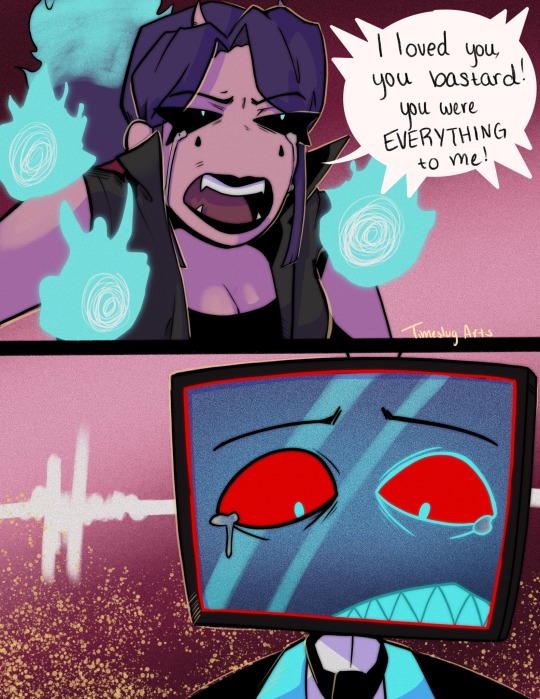
Part 1
I need to make them suffer 🩵💖
I just want to say the love that Vera and Vox warms my heart
Thank you all
#vox#vox x reader#vox x oc#Vera x Vox#hazbin hotel#hazbin art#hazbin vox#hazbin hotel art#hazbin hotel oc#hazbin hotel original character#hazbin hotel vox
140 notes
·
View notes
Text

Tongue :)
#hazbin hotel#hazbin hotel x oc#hazbin hotel oc#hazbin hotel x reader#vox#hazbin hotel vox#vox x reader#vox x oc#Vera x vox
171 notes
·
View notes